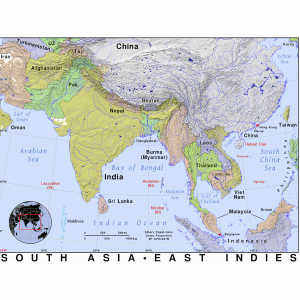Kush Aggarwal
January- December 2022
Introduction:
India and China, two most populous and largest countries in Asia, have a significant impact over the south Asian region. The relationship between the two countries is marked by conflicts and cooperation, with both the nations being rivals in some aspects and partners in others. Interestingly, the Sino-Indian relation is the perfect example of having High politics and low politics coordination simultaneously. The relationship of India and China has its root in history dating back by 2000 years, in interaction through trade and cultural exchanges. In the modern era, the relationship between India and China has been shaped by a variety of factors, including geopolitical considerations, economic interests, and territorial disputes resulting in 3 major border incidents- the Sino-Indian War of 1962, the border clashes in Nathu La and Cho La in 1967, China-India skirmishes in 2020. Despite all the clashes, there has been improving economic and strategic ties between Beijing and New Delhi.
Before discussing further challenges in the relation and its importance, it is important to understand how China became a superpower in a relatively short span of time. As the two main protagonists of the Cold War after WWII, the Soviet Union (USSR) and the United States (US) rose to superpower status. The USSR fell apart in 1991, leaving a weakened Russia and an increasingly powerful US. Until now, it has not changed. The USA is still the superpower with its ever-increasing military budget. But the US status has several challenges such as Russia, India, China, Germany. While the status of Russia and India as emerging superpowers is debatable, China’s role as the next dominant superpower appears to be just around the corner. We are now going to talk about some of the vital factors which catalyzed the growth of China as a superpower of the world.
The first factor is China’s geographic position and its size. China is the world’s fourth largest country by land area, straddling East Central Asia with coasts on the South China Sea, East China Sea, and Yellow Sea. China shares its border with 14 nations, resulting in exercising its influence over small countries in south Asia. China’s strategic position gives it access to the sea and global trade routes to Europe and the Americas, as well as maritime borders with many other nations. The second factor is China’s economic power and influence, China’s sole political actor, the Chinese Communist Party (CPC) controls all significant activity. Since the introduction of the Open Door Policy in 1979, China has witnessed its growth in GDP from US$178 billion to US$14.72 trillion in 2020, which is the 2nd largest economy after the US. China is a major producer and exporter of aluminum, gold, iron, magnesium, and other metals. This is due to China’s direct access to reserves in Africa, where they have recently acquired mineral rights in several countries. These are a few of the various factors which resulted in China emerging as a superpower.
Bilateral relations:
Now let us talk about the headline of our essay, India-China relation. The relation between the two countries started on a positive note. On 1 April, 1950, India became the first non-socialist bloc country to establish diplomatic relations with the People’s Republic of China. But the 1962 Sino-Indian war disturbed whole relations (B.M Jain,2004). The animosity and hostilities grew during the decade of 1959 – 1976, which saw the bad patch in the relationship during the war in 1962. The best possible assumptions – Hindi Chinni bhai bhai period got changed into Hindi-Chinni bye bye period (Arvind Kumar,2010). Prime Minister Rajiv Gandhi’s landmark visit in 1988 began a phase of improvement in bilateral relations. In 1993, the signing of an Agreement on the Maintenance of Peace and Tranquility along the Line of Actual Control (LAC) on the India-China Border Areas during Prime Minister Narasimha Rao’s visit reflected the growing stability and substance in bilateral ties. In 2006, India and China signed the Education Exchange Programme (EEP), which is an umbrella agreement for the two countries’ educational cooperation. The current scenario of India-China relations is marked by a mix of cooperation and competition. The two nations have been engaged in a border dispute in the Himalayan region for many years, with both sides accusing the other of encroachment. Dispute on McMahon line in the eastern sector. Johnson and McDonald line the western sector in Ladakh fuels the tension between New Delhi and Beijing. The tension between the two nations reached its peak in 2020 when a deadly clash between the Indian and Chinese troops in the Galwan Valley led to the death of several soldiers on both sides. Despite this tension, India and China have substantial economic ties. China is India’s largest trading partner, with bilateral trade worth $92.68 billion in 2020. China also invests heavily in India’s infrastructure and other sectors, making it a significant recipient of Chinese investment.

Another source of tension between India and China is their competing interests in the Indian Ocean region. China has been rapidly expanding its influence in the region, through the construction of ports and other infrastructure projects, while India sees the region as its backyard and is keen to maintain its influence. India and China have a complicated and multifaceted relationship. While efforts have been made to improve the relationship and collaborate on areas of mutual interest, there are several sources of tension and conflict, particularly in trade, investment, and territorial disputes. The relationship between India and China will undoubtedly remain an important factor in the international system for many years to come.
The future of India-China relations clearly has implications for Asia, if not the entire world. However, the public spotlight has only exacerbated their already complex web of problems and potential solutions. (S. Singh, 2008)
Impact on the South Asian Region
Let us now see how the dynamics of cooperation and conflict between India and China has its impact on South Asia and why it is important for both the countries. South Asia region includes the 7 countries and Indian ocean. It is strategically important for both the countries, whether for trade or for military position advantage. Current strategic and economic trends indicate that South Asia’s importance in China’s national security calculus is likely to increase in the 21st century. That’s why both the countries want to increase their influence in the region. China remains an economically more attractive and politically more reliable partner for India’s neighbours.(Wagner,2016)

Although it has become a necessity for India due to China’s presence in its neighborhood, India can’t let China increase its presence as it will have catastrophic effects on India’s security. A Sino-Indian rivalry in southern Asia and the northern Indian Ocean could become a dominant feature of Asian geopolitics in the future(Malik ,2001). China’s growing regional influence, particularly through its Belt and Road Initiative (BRI), has alarmed India. The Belt and Road Initiative (BRI) is a massive infrastructure development plan that aims to connect China with other countries via a network of railways, highways, and ports. BRI acts as a rebuttal to the much-touted US “pivot to Asia.” Promoting economic development in Xinjiang, China’s westernmost province, where separatist violence is on the rise, India views the BRI as a means for China to increase its regional influence, which could jeopardize India’s security interests. India has opposed the BRI and refused to join the initiative, citing concerns about the project’s transparency and strategic implications.
The economic ties between India and China have significant implications for the South Asian region’s economy. Concerns about India’s economic security have arisen as a result of China’s growing economic influence in the region. India is concerned about China’s investments in its neighbors, which it sees as an attempt to undermine India’s regional influence. However, economic ties between India and China can be viewed as an opportunity for the South Asian region. Both countries are major trading partners for the region’s countries and their economic cooperation could lead to increased regional economic growth and development.
Conclusion:
In Conclusion, the relationship between India and China has significant implications for the South Asian region. Their relationship has complex geopolitical, economic, and security implications that must be carefully considered. The tensions between India and China have had a considerable influence on the South Asian area, especially in terms of strategic competitiveness and economic ramifications. It remains to be seen how these tensions will play out in the future and how they will affect the region. While efforts have been made to enhance the relationship and collaborate on areas of mutual interest, there are a number of causes of friction and conflict, particularly in trade, investment, and territorial issues. While the relationship between two countries is marked by both cooperation and competition, both nations must engage in dialogue and cooperation. The partnership between India and China has the potential to impact the future of the international system, thus both nations must work together to develop a stable and productive relationship. Compromise, conversation, and a willingness to confront unpleasant issues will be required. Finally, the future of India-China relations will be determined by both countries’ capacity and willingness to discover common ground and strive towards a shared vision for the future.
References:
Jain, B. M. (2004). India–China relations: Issues and emerging trends. The Round Table, 93(374), 253-269.
Singh, S. (2008). India–China relations: Perception, problems, potential. South Asian Survey, 15(1), 83-98.
Kumar, A. (2010). Future of India-China relations: challenges and prospects. Revista UNISCI, (24), 187-196.
Wagner, C. (2016). The Role of India and China in South Asia. Strategic Analysis, 40(4), 307-320.
Malik, J. M. (2001). South Asia in China’s foreign relations. Pacifica Review: Peace, security & global change, 13(1), 73-90.

